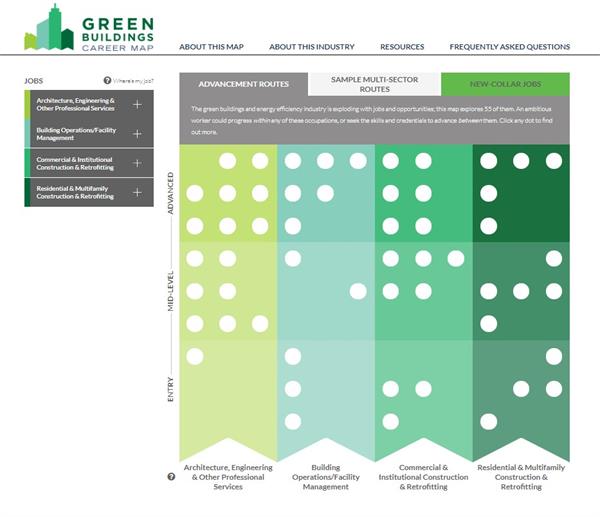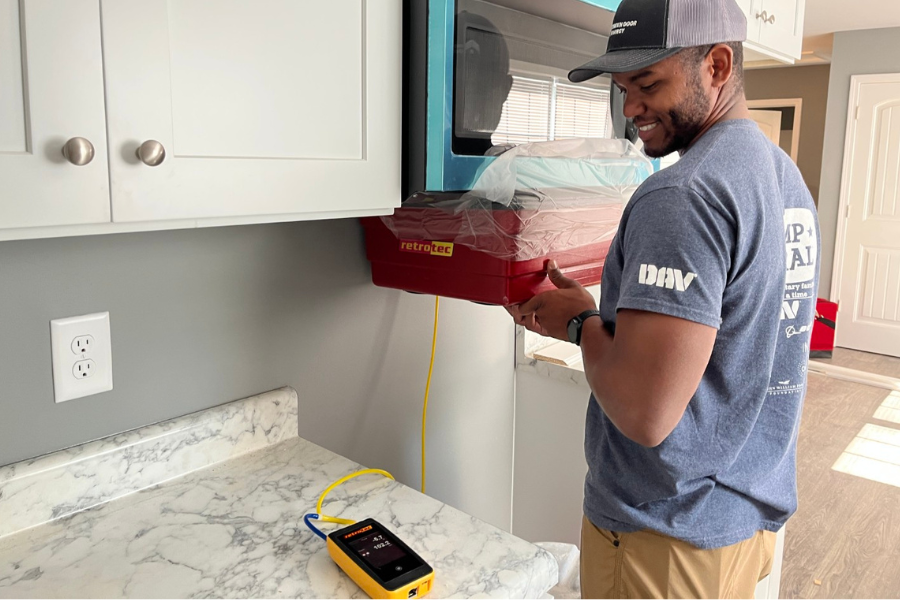Apr 6, 2021
The New Resource Growing the Pipeline of Qualified Workers for Energy Efficient Buildings
Take a look at the Green Buildings Career map, the easiest-to-understand career map for the energy efficiency field.
By: Gwen Brown

Jobs in high performance building design, construction, and retrofitting are crucial roles in the U.S. economy. And they will only become more important as the nation looks to tackle thorny issues like climate change and infrastructure. Yet, how often has your company struggled to fill job openings with qualified candidates?
In spite of the fact that the energy efficiency sector is one of the fastest-growing U.S. industries, students and job seekers do not always have access to clear information about how to get into the industry, what their career progression will look like, and what training they need for different roles. This creates challenges for hiring and ensuring a sufficient pipeline of future workers as the industry grows. Similarly, as a worker in this space, it may not always be obvious what steps to take to advance your career, particularly if you are interested in transitioning to a different sector of the industry.
A newly released resource, funded by the U.S. Department of Energy’s Building Technologies Office, aims to tackle these challenges and foster a robust and inclusive pipeline of qualified workers to meet employer demand.
The Green Buildings Career Map, developed by the Interstate Renewable Energy Council (IREC) with the support of experienced industry partners including the Building Performance Association, is an interactive and educational career map highlighting the breadth of rewarding career opportunities in building energy efficiency. Read on to learn more about this tool and how it can be used by different audiences to address diverse workforce development needs related to energy efficiency in buildings.
About the Green Buildings Career Map
The Green Buildings Career Map features 55 jobs in energy efficiency for buildings across four different industry sectors, as well as over 300 potential advancement routes. The Map was created with the input of an experienced, cross-sector group of industry subject matter experts who helped ensure its accuracy and real-world usefulness.
IREC and these industry subject matter experts progressed through a structured process to identify critical, market-valued, energy efficiency occupations and career paths. From there, the information was integrated into an interactive and engaging career map. Users can click on a job to learn more about what the role involves, the salary range, required training, and what future roles it could lead to. The map shows not only potential career progression paths within the same sector of the industry but also pathways for transitioning from one sector to another.

Growing the (Inclusive) Pipeline of Qualified Workers
The Map can be used by a wide range of audiences from job seekers and workers to school and career counselors, training providers, and recruiters. For training organizations and schools, it provides an invaluable resource to help prospective and current students gain a clearer picture of the career options available to them and why a career in this industry is worth pursuing.
As explained by Roger Ebbage, CEM, a faculty member of Energy and Water Education Programs at Lane Community College and a subject matter expert who contributed to the Map’s development, “I have managed the Commercial Building Energy Management two-year degree program at Lane Community College in Eugene, Oregon for 30 years. NEVER have we had a one-stop resource that assists prospective students with such a complete, detailed view of the Green Building workforce options as the Green Buildings Career Map. I will reference the Green Buildings Career Map EVERY TIME I speak with a prospective student. It is simply my best tool for student recruitment.”
Additionally, because the Map shows advancement routes from a given role to others, job seekers from entry-level to advanced can use the map to identify opportunities for taking the next step in their careers. Recruiters can showcase the variety of advancement opportunities stemming from specific jobs.
All of these uses contribute to one overarching goal: growing the pipeline of qualified workers for jobs related to the energy efficiency of buildings. As part of this, IREC is also working to ensure that the Map increases awareness of these career opportunities among underserved communities to ensure that job growth is inclusive and reflects the diversity of the nation.
IREC and its partners are committed to connecting with organizations serving low-income and other vulnerable populations of learners and workers, such as women and minorities, in outreach about energy efficiency careers. Additionally, to ensure accessibility to jobseekers with diverse levels of education, the Map highlights 32 “New-Collar” Green Jobs—skilled roles that do not require a four-year college degree.
To explore the Green Buildings Career Map, visit https://greenbuildingscareermap.org/. If you’re interested in learning more, you can also register here for an informational webinar about the Map that will be held on Tuesday, May 11, 2021 at 2pm Eastern Time.





